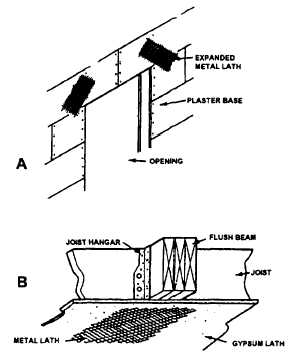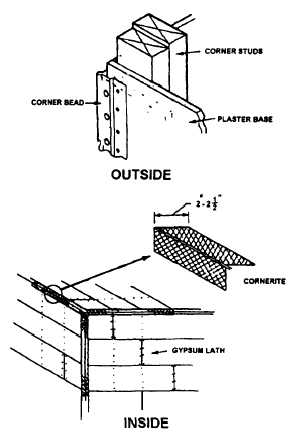Figure 7-7.-Metal lath used to minimize cracking.
Figure 7-8.-Plaster reinforcing at corners.
on the underside of the soffit. A metal base acts as a flush
base at the bottom of a plaster wall. It also serves as a
plaster screed.
Joint Reinforcing
Because some drying usually takes place in the
wood framing members after a structure is completed,
some shrinkage is expected. This, in turn, may cause
plaster cracks to develop around openings and in the
comers. To minimize, if not eliminate, these cracks, use
expanded metal lath in key positions over the plaster-
base material as reinforcements. Strip reinforcement
(strips of expanded metal lath) can be used over door
and window openings (fig. 7-7, view A). A 10- to
20-inch strip is placed diagonally across each upper
comer of the opening and tacked in place.
Strip reinforcement should also be used under flush
ceiling beams (fig. 7-7, view B) to prevent plaster
cracks. On wood drop beams extending below the
ceiling line, the metal lath is applied with furring nails
to provide space for keying the plaster.
Corner beads of expanded metal lath or of
perforated metal (fig. 7-8) should be installed on all
outside comers. They should be applied plumb and
level. Each bead acts as a leveling edge when walls are
plastered and reinforces the comer against mechanical
damage. To minimize plaster cracks, reinforce the inside
comers at the juncture of walls and ceilings. Metal lath,
or wire fabric, is tacked lightly in place in these corners.
Control joints (an example of which is shown in
fig. 7-9) are formed metal strips used to relieve stresses
and strains in large plaster areas or at junctures of
dissimilar materials on walls and ceilings. Cracks can
develop in plaster or stucco from a single cause or a
combination of causes, such as foundation settlement,
material shrinkage, building movement, and so forth. The
control joint minimizes plaster cracking and assures
proper plaster thickness. The use of control joints is
extremely important when Portland cement plaster is
used.
Plastering Grounds
Plastering grounds are strips of wood used as
plastering guides or strike-off edges and are located
around window and door openings and at the base of the
walls. Grounds around interior door openings (such as
fig. 7-10, view A) are full-width pieces nailed to the
sides over the studs and to the underside of the header.
They are 5 1/4 inches wide, which coincides with the
standard jamb width for interior walls with a plaster
7-8



